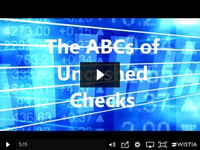 This video presentation is designed to give the viewer a basic understanding of the problem of uncashed 401(k) distribution checks.What are uncashed distribution checks, and why should I care?
This video presentation is designed to give the viewer a basic understanding of the problem of uncashed 401(k) distribution checks.What are uncashed distribution checks, and why should I care?
Uncashed distribution checks occur when retirement plan participants fail to cash or deposit a distribution from their qualified retirement savings account, for a variety of reasons, including:

Thanks for reporting a problem. We'll attach technical data about this session to help us figure out the issue. Which of these best describes the problem?
Any other details or context?
This video presentation is designed to give the viewer a basic understanding of the problem of uncashed 401(k) distribution checks.
What are uncashed distribution checks, and why should I care?
Uncashed distribution checks occur when retirement plan participants fail to cash or deposit a distribution from their qualified retirement savings account, for a variety of reasons, including:
- an incorrect mailing address
- a lost or misplaced physical check
- a distribution check that was not anticipated
- as the result of inaction on the part of the participant
Uncashed distribution checks are a growing problem for plan sponsors, as the numbers of small-balance accounts and separated participants grow. For qualified plans, uncashed distribution checks can represent a fiduciary liability, since the amounts must be considered plan assets until the check is cashed or otherwise resolved. Over time, the numbers of uncashed checks can mount, along with the administrative burden and fiduciary risk.
Plans can take steps to minimize the incidence of uncashed distribution checks, as well as to resolve the situations that inevitably occur.
Why do uncashed distribution checks occur?
Uncashed, or stale-dated checks typically occur under the following circumstances:
- Mandatory Distributions, less than $1,000: When plans cash out participants with balances of less than $1,000, it’s common for these checks to go uncashed.
- Uncashed Plan Distributions:Participants request distributions at their normal retirement age, or required minimum distributions at age 70-1/2 -- yet they never cash their checks.
- Returned Checks:Checks of any amount that are returned as undeliverable by the U.S. Postal Service
- Unresponsive Participants: Checks of any amount that are requested, but simply not acted upon by the participant
These problems can persist, as plan sponsors will often have incorrect address information, and neither alternate payees nor beneficiaries can be found.
Why are uncashed distribution checks considered a problem?
- Uncashed distribution checks (or stale-dated checks) are considered plan assets, so plan sponsors continue to incur administration costs, while participants are separated from their retirement savings.
- Additionally, uncashed check funds accumulate no interest or earnings, and if mishandled, can represent a potential liability to plan sponsors.
How can plan sponsors effectively deal with uncashed distribution checks?
Solutions that Resolve Existing, Uncashed Distribution Checks:
- For uncashed distribution checks less than $5,000, work with an automatic rollover service provider to roll over their funds to a safe harbor IRA, established in the name of the participant.
- Upon opening and funding of the safe harbor IRA, your plan will be deemed to have fulfilled its fiduciary responsibilities.
- Ongoing, the automatic rollover service provider should continue to perform searches in order to re-unite the participant or their beneficiary with the retirement savings.
Preventive Solutions that Minimize the Incidence of Uncashed Distribution Checks:
- For all separated participants with less than $5,000, implement an automatic rollover (or safe harbor IRA) program. Importantly, be sure to include accounts with less than $1,000 in the automatic rollover program, as many plans elect to cash out these participants, unwittingly creating an even larger problem with uncashed distribution checks.
- Periodically update your records for lost or missing participants. Many separated participants do not maintain current information. A cost-efficient participant location service can increase the odds that mailed, physical distribution checks will reach their intended destination.
Where can I get additional information:
For more information, visit:
https://info.rch1.com/rch-uncashed-check-service
